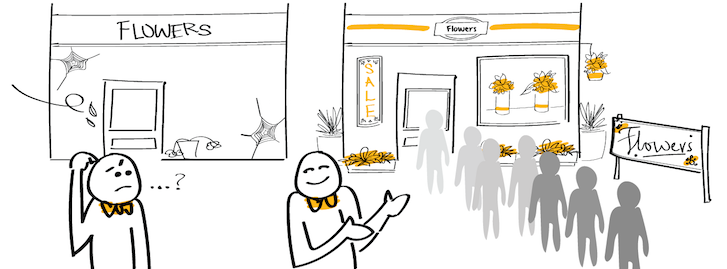So a client has asked you for ideas on how they can increase their sales. They may have even asked you about making their store go “viral.”
You know, as cringeworthy as that sounds to people who run agencies, it’s actually possible — as long as you help the client redefine their understanding of virality, especially when it comes to ecommerce stores.
For ecommerce, successful virality isn’t getting a million visits. Virality is about getting as many word-of-mouth sales as possible. It means turning your existing customers into magnets for more customers. At ReferralCandy, we help Shopify stores get more sales by making word-of-mouth referrals easy.
After studying some of our most viral customers, we’ve discovered four approaches that can increase a store’s word-of-mouth potential.
You might also like: 3 Digital Marketing Strategies for High-Priced Inventory
1. Increase the size of your potential audience

One of the requirements for mass virality is a huge audience: you can’t go viral in the traditional sense if you’re going after a super niche audience. You need a wide cross-section of the general population to be able to relate with the product.
An example of this is Quad Lock, an iPhone bike mount. One of the reasons that their Kickstarter campaign did so well is because they presented a solution to a very common problem for a large audience. They went after iPhone owners who were looking for a device mount. Most people who hear about Quad Lock can usually think of someone in their social circle that would be interested. It’s a big reason why their referral program is among the most effective we’ve seen.
So what if your client’s product addresses a very small audience? Aside from adjusting their expectations, you can look to widen the appeal of the product. Quad Lock successfully broadened their market by highlighting a variety of use cases, showing the product being used while biking, jogging and driving.
Takeaway:
Work with your client to explore ways to adapt their products to hit adjacent markets. Just as Quad Lock increased their virality by covering three different markets by making tweaks on one base product, you may be able to uncover similar opportunities.
And it doesn’t always need to be a product change — think about how baking soda found a huge new market as a deodorizer.
2. Crank up the emotional connection

A powerful way to increase virality is to bake emotion into the product experience. Project Repat is an perfect example of this. Look at their hero shot:

According to founder Nathan Rothstein, word-of-mouth referrals are such a big part of their sales because of the emotional nature of their product.
Project Repat drives word-of-mouth viral sales by attaching their product to an emotionally-charged life event: teenagers going off to college. It turns out that mothers of college freshmen drive a large portion of their referral sales. By delivering a high-quality keepsake for a life milestone, Project Repat gets their customers talking and raving about their products.
Takeaway:
What emotional cords can your clients’ products hit? Before you think that their product is a commodity that can’t possibly have a sentimental dimension, consider that Dove has done well for itself despite really just being a bar of soap. Here are more ideas on emotional marketing.
Can your clients’ products be attached to a life event? Even if you can’t associate yourself to a major life milestone like Project Repat, consider tapping into things like holidays and calendar events or religious traditions.
You might also like: How Understanding a Brand Mission Will Make You a Better Designer
3. Show off a strong personality

If your client has a new take on something, or has a passionate opinion about their industry, play that up and emphasize it. People love talking about people who take a stand, especially if they don’t agree with it!
Leesa Sleep is a perfect example of this, with their foldable, shippable mattress. Their reason for existing is to take on the mattress industry by turning over a lot of assumptions. This leads to a lot of buzzworthy elements that lead to high number of customer referrals.
Leesa Sleep offers a 100-night trial period, transparent pricing and free shipping. These things are unheard of in the traditional retail mattress industry (which operates on a sales model similar to buying cars), and this makes it fun for their customers to spread the word.
Takeaway:
Does your client differ from the industry norm in any way? How can you amplify those differences? Remember that you don’t need to radically alter the product. Sometimes it’s the little touches, like writing handwritten notes to bloggers or their best customers.
Do the founders have unique personalities or viewpoints that can add to the product narrative? Having an outspoken figurehead for the company helps keep the company’s story top-of-mind, helping you shape what customers say about your client to their friends.
4. Nail your visual marketing

On your first visit to Greats, you immediately notice that they’ve placed a heavy emphasis on being a store driven by visuals and pictures.
Founder Ryan Babenzien was deliberate about making visuals a key part of their marketing plan. Beyond their award-winning website design, visuals play a role in their social network marketing as well. They have a huge following on Instagram, posting multiple times a day with pictures that tie deeply into their brand image.
Even their refer-a-friend page is visual: it’s one of the reasons why Greats is one of our best-performing customers.
Takeaway:
If your client is selling anything related to beauty, design, fashion or luxury — you can’t underestimate the power of having strong visuals. Committing to Instagram, Pinterest or any other relevant visually-driven communities should be considered in their marketing plan.
Conclusion
Going viral isn’t about getting a billion YouTube views; in ecommerce it’s about generating word-of-mouth sales. It’s about finding something buzzworthy about an offering, and tweaking it so that customers can’t wait to talk about them.
As we’ve seen above, sometimes the product just needs a bit of rethinking to bring out what makes them word-of-mouth friendly. Let’s recap:
- Expand the audience
- Hook into a customer's emotions
- Show off your personality
- Emphasize visuals in marketing
Before advising your clients to spend more on PPC or to invest in new campaigns, consider what tweaks you can make to increase their own unique brand of virality.
You might also like: 6 Tips for Crafting Great Web Copy That Converts









